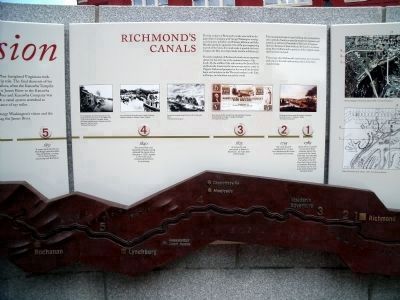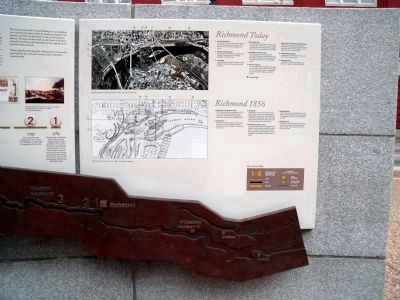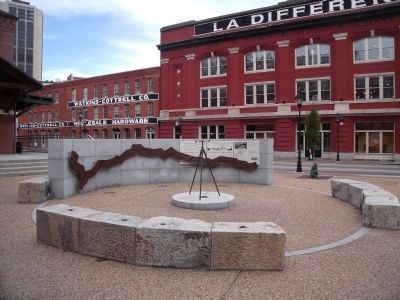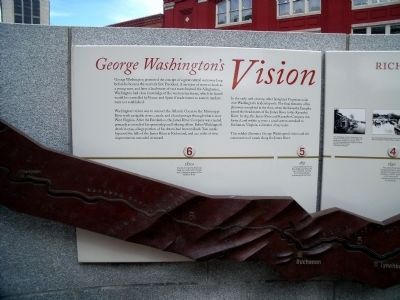Shockoe Slip in Richmond, Virginia — The American South (Mid-Atlantic)
George Washington’s Vision
Washington’s vision was to connect the Atlantic Ocean to the Mississippi River with navigable rivers, canals, and a land portage through what is now West Virginia. After the Revolution, the James River Company was created, primarily as a result of his sponsorship and lobbying efforts. Before Washington’s death in 1799, a large portion of his dream had been realized. Two canals bypassed the falls of the James River at Richmond, and 220 miles of river improvements extended westward.
In the early 19th century, other farsighted Virginians took over Washington’s leadership role. The final elements of his plan were completed in the 1820s, when the Kanawha Turnpike joined the headwaters of the James River to the Kanawha River. In 1835, the James River and Kanawha Company was formed, and within 15 years a canal system stretched to Buchanan, Virginia, a distance of 197 miles.
This exhibit illustrates George Washington’s vision and the construction of canals along the James River.
Richmond’s Canals
The first sections of Richmond’s canals were built by the James River Company, with George Washington serving as its honorary president, and Thomas Jefferson and John Marshall among its supporters. One of the great engineering marvels of the times, the canals made it possible for boats to bypass the falls, most importantly the falls in Richmond.
The early completion of Richmond’s canals was an important element in the city’s rise as the industrial center of the South. By the middle of the 19th century, the James River and Kanawha Canal was the main transportation artery in Virginia. Richmond prospered as the central link between farms and industries in the West and markets in the East, in Europe, and elsewhere around the world.
The monumental task of canal building was accomplished over a period of nearly 70 years by numerous engineers and artisans, as well as by thousands of slave and immigrant laborers. Remains of their work can be found in locations along the riverfront, and in portions of the original canals that have been restored.
These maps show Richmond’s canal system as it was in its peak years in the mid-19th century, and as it has been restored today.
Richmond Today
1 Canal Wall Remains
Portions of the James River and Kanawha Canal wall still remain behind the Civil War Visitor Center at the Tredegar Iron Works.
2 Haxall Canal Restoration
The entirety of the Haxall Canal has been restored, running from the Tredegar headgates to 12th Street.
3 Canal Walk
A pedestrian walk along the restored canals includes historical markers and outdoor exhibits.
4 Great Basin Site
The original turning basin for canal boats is now the site of the James Center. Dozens of canal boats and bateaux were uncoverd when the site was excavated in the 1980s.
5 Tidewater Connection Locks
Two of the original stone locks that connected the canal to the Richmond Dock have been preserved, and are now part of the restored James River and Kanawha Canal.
6 New Turning Basin
The new place on the restored James River and Kanawha Canal in which canal boats can turn around and take on passengers is located between Virginia and 14th Streets.
7 James River and Kanawha Canal Restoration
Portions of the canal that originally connected the Great Basin to the Richmond Dock have been restored between 12th Street and the Triple Crossing.
8 Richmond Dock Remains
A large part of the Richmond Dock still exists below Tobacco Row.
9 Great Ship Lock
Completed in 1854, the granite lock remains in good condition to this day.
Richmond 1856
1 James River and Kanawha Canal
With its first sections completed by 1789, the James River and Kanawha Canal ultimately ran behind the Tredegar Iron Works and connected to the Great Basin.
2 Haxall Canal
Originally a raceway dug to power a local flour mill, the Haxall Canal eventually extended from the Tredegar Iron Works to 12th Street.
3 Great Basin
Canals were so narrow that basins were constructed in which the long baits and barges could turn around. The Great Basin, completed in 1800, was three blocks long and a block wide, between 8th and 11th Streets and Cary and Canal Streets.
4 Tidewater Connection Locks
A series of locks raised and lowered boats between the Great Basin and the Richmond Dock — a drop of 69 feet. The first set, 13 wooden locks, was completed in 1811. These were replaced by 5 granite locks in 1854.
5 Richmond Dock
A dock, extending from 26th Street to 14th Street, with a large wooden lock connecting it to Rockett’s Landing, was in operation by 1822.
6 Great Ship Lock
In 1854, a new 180-by-300-foot lock was completed, enabling the largest sailing ships to

Photographed By Bernard Fisher, October 25, 2009
4. Richmond's Canals panel
Captions (left to right)
The Chesapeake and Ohio Railroad running along the Richmond Dock. In the 1880s, the canals were replaced by railroads, which ultimately extended across Virginia and West Virginia to the Ohio River. The Valentine Museum
Excursion boats along the canal near Lynchburg. Mariners Museum, Newport News, Virginia
Canal boat approaching Richmond from the west, 1870. The Valentine Museum
Bond issued by the James River and Kanawha Company, incorporating an image of George Washington. The Valentine Museum
Painting of ships arriving at Rockett’s Landing in Richmond, by A. C. Pleasant, 1840s. The Valentine Museum
The Chesapeake and Ohio Railroad running along the Richmond Dock. In the 1880s, the canals were replaced by railroads, which ultimately extended across Virginia and West Virginia to the Ohio River. The Valentine Museum
Excursion boats along the canal near Lynchburg. Mariners Museum, Newport News, Virginia
Canal boat approaching Richmond from the west, 1870. The Valentine Museum
Bond issued by the James River and Kanawha Company, incorporating an image of George Washington. The Valentine Museum
Painting of ships arriving at Rockett’s Landing in Richmond, by A. C. Pleasant, 1840s. The Valentine Museum
Topics and series. This historical marker is listed in these topic lists: Bridges & Viaducts • Industry & Commerce • Man-Made Features • Waterways & Vessels. In addition, it is included in the Former U.S. Presidents: #01 George Washington series list. A significant historical year for this entry is 1799.
Location. 37° 32.014′ N, 77° 25.975′ W. Marker is in Richmond, Virginia. It is in Shockoe Slip. Marker is at the intersection of South 14th Street (U.S. 360) and Dock Street, on the right when traveling south on South 14th Street. Touch for map. Marker is in this post office area: Richmond VA 23219, United States of America. Touch for directions.
Other nearby markers. At least 8 other markers are within walking distance of this marker. Burnt District (a few steps from this marker); Atlantic Sturgeon (within shouting distance of this marker); Canal Walk / Historic Canals (within shouting distance of this marker); Mayo's Bridge (within shouting distance of this marker); Tobacco District (within shouting distance of this marker); James River & Kanawha Canal (within shouting distance of this marker); Use of Arms (within shouting distance of this marker); New Turning Basin (within shouting distance of this marker). Touch for a list and map of all markers in Richmond.
Also see . . .
1. James River and Kanawha Canal Historic District

Photographed By Bernard Fisher, October 25, 2009
5. Richmond Today / Richmond 1856 panel
Captions
On the upper left is an “Aerial photograph of Richmond, March 1999." The City of Richmond
On the lower left is a “Map of Richmond, by M. Ellyson, 1856." The Valentine Museum
On the lower right is a "Key to Bronze Map"
On the upper left is an “Aerial photograph of Richmond, March 1999." The City of Richmond
On the lower left is a “Map of Richmond, by M. Ellyson, 1856." The Valentine Museum
On the lower right is a "Key to Bronze Map"
2. Riverfront Canal Cruises in Richmond. Venture Richmond (Submitted on October 28, 2009.)

Photographed By Bernard Fisher
6. Bronze map of the "Stages of Canal and Turnpike Construction."
1 1789
Canals were completed by the James River Company around two portions of the James River falls. One extended approximately 3 miles from what is now the Byrd Park Pump House to downtown Richmond. The second ran for 200 yards below present-day Williams Island.
2 1795
The canal became operational for 7 miles, from Westham to 8th Street in downtown Richmond.
3 1825
An extension was completed to Maiden’s Adventure, 30 miles west of Richmond.
4 1840
The James River and Kanawha Company, having replaced the James River Company in 1835, opened a 147-mile canal connecting Richmond to Lynchburg.
5 1851
A canal replacing the old Blue Ridge canal structures was completed, running 47½ miles between Lynchburg and Buchanan.
6 1820s
The link to the Ohio River was made by a 200-mile turnpike and a navigation system on the Kanawha River.
Canals were completed by the James River Company around two portions of the James River falls. One extended approximately 3 miles from what is now the Byrd Park Pump House to downtown Richmond. The second ran for 200 yards below present-day Williams Island.
2 1795
The canal became operational for 7 miles, from Westham to 8th Street in downtown Richmond.
3 1825
An extension was completed to Maiden’s Adventure, 30 miles west of Richmond.
4 1840
The James River and Kanawha Company, having replaced the James River Company in 1835, opened a 147-mile canal connecting Richmond to Lynchburg.
5 1851
A canal replacing the old Blue Ridge canal structures was completed, running 47½ miles between Lynchburg and Buchanan.
6 1820s
The link to the Ohio River was made by a 200-mile turnpike and a navigation system on the Kanawha River.
Credits. This page was last revised on February 1, 2023. It was originally submitted on October 28, 2009, by Bernard Fisher of Richmond, Virginia. This page has been viewed 1,595 times since then and 36 times this year. Photos: 1, 2, 3, 4, 5, 6. submitted on October 28, 2009, by Bernard Fisher of Richmond, Virginia.


